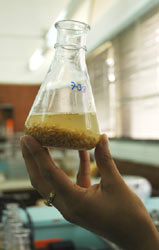Health diagnosis of maize genetic resources
Contributors to this page: CIMMYT, Mexico (Suketoshi Taba, Bonnie J. Furman), with inputs also received from IITA, Nigeria (Dominique Dumet), EMBRAPA (maize and sorghum genebank), Brazil (Flavia Teixeira), USDA(ARS/NC7, ISU), USA (Mark Millard).
Inspection and certification (purity analysis of seeds)
A multistage seed inspection by the genebank curator or seed health personnel is required for the maintenance of purity of the seed accession.
- The genebank and seed health personnel (quarantine personnel) should inspect the purity and quality of the seed accessions for incoming (introductions) and outgoing (seed shipments and conservation) in the genebank.
- The seed certification by the seed health laboratory facilitates both incoming and outgoing seed movements, including conservation in the genebank.
- The dried and cleaned seed lot should go through the seed health inspection for the seed shipment (outgoing seeds) and conservation in the genebank.
- The seed lots should be macroscopically inspected (as done at the CIMMYT seed health laboratory) for fungal infection, insect damage, weed seeds and others.
- As needed, the seed wash filter test and freeze blotter test should be performed for the presence of spores, smuts and oospores for the quarantined fungi (ex. Ustilago maydis, Peronosclerspora spp., Heterodera zeae, Cephalosporium maydis) and in the greenhouse germination test for seed-born bacterial or viral pathogens (ex. Panatoea stewartii) and seed viability. Click here for more information.
- The absence or presence of the transgenic events in the seed accessions should also be inspected.
 |
 |
|
Inspecting seed lots in the CIMMYT seed health laboratory (photos: CIMMYT) |
|
List of pests and diseases of quarantine importance
More detailed information is also available from the page on safe movement of germplasm, on this website. Click here for details.
See also the list of pests and diseases for this crop listed in the crop regeneration guidelines.
The list below mentions some of the pests/diseases that were considered important worldwide, but many of them may or may not have relevance in specific countries. It also does not consider pests/diseases of limited relevance (e.g. only important in very few countries).
List of important pests per region
Pantoea stewartii
Europe: Austria, Greece, Italy, Poland, Romania, Russian Federation, Serbia and Montenegro, Switzerland.
Asia: China, India, Malaysia, Peninsular Malaysia, Thailand, Vietnam.
Central America & Caribbean: Costa Rica, Puerto Rico, Trinidad and Tobago.
North America: Canada, Alberta, British Columbia, Ontario, Mexico, USA.
South America: Bolivia, Brazil, Sao Paulo, Guyana, Paraguay, Peru.
Clavibacter michiganensis pv. Nebraskensis
North America: Canada, USA.
Cephalosporium maydis
Asia: India.
Africa: Egypt.
Wheat streak mosaic virus
Europe: Hungary, Italy, Ukraine.
Asia: Iran.
North America: Canada (Ontario), USA (Kansas).
Peronosclerospora maydis
Asia: China, Taiwan, India, Indonesia, Java, Nusa Tenggara, Israel, Japan, Thailand.
Africa: Congo Democratic Republic.
Central America & Caribbean: Jamaica.
South America: Argentina, Venezuela.
Oceania: Australia.
Europe.
Peronosclerospora sorghi
Asia: Bangladesh, China, Taiwan, India, Iran, Japan, Nepal, Pakistan, Philippines, Thailand, Yemen.
Africa: Benin, Botswana, Burkina Faso, Burundi, Egypt, Ethiopia, Ghana, Kenya, Malawi, Mauritius, Mozambique, Nigeria, Rwanda, Somalia, South Africa, Sudan, Swaziland, Tanzania, Uganda, Zambia, Zimbabwe.
Central America & Caribbean: El Salvador, Guatemala, Honduras, Nicaragua, Panama, Puerto Rico.
North America: Mexico, USA.
South America: Argentina, Bolivia, Colombia, Peru, Uruguay, Venezuela.
Oceania: Australia.
Peronoscleropsora philippinensis
Asia: China, India, Indonesia, Japan, Nepal, Pakistan, Philippines, Sulawesi, Taiwan, Thailand,
Africa: Mauritius (Mauritius Sugar Industry Research Institute, 1986).
North America: USA (EPPO, 2005).
Sclerophthora rayssae f.sp. zeae
Asia: India, Myanmar, Nepal, Pakistan, Thailand.
Options for testing procedures
The seed health procedures ensure the safe movement of the maize germplasm, following the international rules and regulations.
- Click here to see CIMMYT’s current list of seed health testing recommendations for maize.
Recording information during health diagnosis
 Applying the latest laboratory methods, CIMMYT staff ensures that seed entering (and leaving) the centre is disease-free (photo: CIMMYT) |
The following information should be recorded for each procedure:
- Accession number (number).
- Introduction ID number (number).
- Collection name or pedigree (number, name).
- Seed quantity received and used (grams or numbers).
- Seed origin (location, year, plot number).
- Date received (year, month, day).
- Category of the seed health tests and names of the pests (test names and the target species).
- Greenhouse germination and inspection (% germination and inspection).
- Results of the seed health test (positive or negative).
- Date released by the seed health lab (date: year month day).
- Observation (any need for follow up, retesting etc).
- Seed exchange policy (MLS, other to specify).
References and further reading
EPPO activities on plant quarantine [online]. 2010. Available from: http://eppo.org/QUARANTINE/quarantine.htm. Date accessed: 30 January 2010.
Mezzalama M, Gilchrist L, McNab A. 2005. Seed Health: Rules and regulations for the safe movement of germplasm. Mexico. D.F., CIMMYT. Available from: http://libcatalog.cimmyt.org/download/cim/93586.pdf. Date accessed: 3 September 2010.
Norma Oficial Mexicana NOM-018-FITO-1995. Por la que se establece la cuarentena exterior para prevenir la introducción de plagas del maíz. Available for download from: senasica.gob.mx/?doc=615. Date accessed: 3 September 2010.
Seed health testing: Maize CIMMYT [online]. Available from: http://apps.cimmyt.org/english/wps/obtain_seed/shl-table2.htm. Date accessed: 30 January 2010.
Comments
- No comments found





Leave your comments
Post comment as a guest